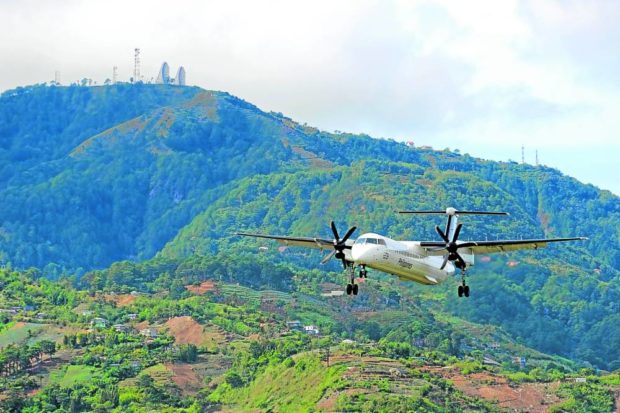Baguio folk negotiate access through airport as flights begin

MAIDEN FLIGHT | The Baguio airport in Barangay Loakan, idle for decades, has started receiving commercial flights when flag carrier Philippine Airlines started its Baguio-Cebu route on Dec. 16. The resumption of operations has affected surrounding households who have been crossing the runway to get to workplaces or schools much faster. (Photo by NEIL CLARK ONGCHANGCO)
BAGUIO CITY, Benguet, Philippines — As many as 5,000 students, workers, and the elderly living near Baguio’s only airport have been forced to walk or drive around the once-idle runway now that commercial flights have resumed there.
The shortest route to schools or workplaces for households surrounding Loakan Airport is the runway itself, but crossing it would not be allowed once runway gates close for 90 minutes before an aircraft lands and another hour when the plane takes off, according to Baguio Ibaloy elder Beauregard Carantes.
Flag carrier Philippine Airlines (PAL) opened its Baguio to Cebu flights beginning with a Dec. 16 maiden flight that flew in 68 passengers from the Visayas and flew out 56 people bound for Cebu.
PAL’s 85-seat Q-400 bombardier aircraft will fly passengers from Cebu on Mondays, Wednesdays, Fridays and Sundays, landing at 10:50 a.m. and taking off at 11:10 a.m.
But with other airlines likely to reopen flights to Baguio, runway gates may be closed much longer each day.
During last week’s session of the city council, an official of the Philippine Air Force Tactical Operations Group, which holds office at Baguio’s Loakan Airport, said their security protocols prohibit runway crossings, explaining that unauthorized individuals are not allowed near military aircraft.
In a community resolution that was approved on Dec. 17, Ibaloy families and other Loakan residents argued that the hours needed for closing the runway could be reduced to minutes.
“A vehicle crossing the runway at 20 kilometers per hour would reach the other side in three to five seconds,” while pedestrians walking at a normal pace would cross the runway in three to five minutes, the resolution asserts.
Original settlers
The Ibaloy households are descendants of the original settlers whose rice fields were expropriated by the American colonial government in order to build the airport in 1934.
The Loakan resolution reminded the government about commitments it made when the American colonial government expropriated their farmlands to build the airport in 1934, among them the “unimpeded” access through the runway of residents and their cattle.”
Carantes said the runway crossing area used to be the pathway used by Ibaloys before the war. The original runway was shorter and had ended at the same pathway which used to lead to the now-defunct Demonstration Mines.
Instead of informing them about the runway regulations through social media posts, “the Civilian Aviation Authority of the Philippines should have first sought from us, indigenous peoples, our free, prior and informed consent as required by the Indigenous Peoples Rights Act of 1997 (Republic Act No. 8371),” the resolution says.